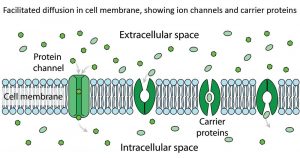Facilitated diffusion
What happens if a substance needs help to move across the plasma membrane? How facilitated diffusion works? Facilitated diffusion is the diffusion of solutes through transport proteins in the plasma membrane. Facilitated diffusion is a type of passive transport. Although facilitated diffusion involves transport proteins, it is still passive transport because the solute moves down the concentration gradient.
Nonpolar small molecules can easily diffuse through the cell membrane. However, due to the hydrophobic nature of the lipids that make up cell membranes, polar molecules (such as water) and ions cannot. Instead, they diffuse across the membrane via transport proteins. A transport protein completely crosses the membrane and allows certain molecules or ions to diffuse across the membrane. Channel proteins, gated channel proteins, and carrier proteins are three types of transport proteins that are involved in facilitated diffusion.
A channel protein, a type of transport protein, acts like a pore in the membrane that quickly lets water molecules or small ions through. Water channel proteins (aquaporins) allow water to diffuse across the membrane at a very fast rate. Ion channel proteins allow ions to diffuse across the membrane.
A gated channel protein is a transport protein that opens a “gate,” allowing a molecule to pass through the membrane. Closed channels have a binding site that is specific for a given molecule or ion. A stimulus causes the “gate” to open or close. The stimulus can be chemical or electrical signals, temperature, or mechanical force, depending on the type of channel closed.
For example, sodium-gated channels in a nerve cell are stimulated by a chemical signal that causes them to open and allow sodium ions to enter the cell. Glucose molecules are too large to diffuse easily across the plasma membrane, so they move across the membrane through closed channels. In this way, glucose diffuses very quickly through the cell membrane, which is important because many cells depend on glucose for energy.
A carrier protein is a transport protein that is specific for an ion, molecule, or group of substances. Carrier proteins “carry” the ion or molecule across the membrane by changing shape after binding of the ion or molecule. Carrier proteins are involved in passive and active transport.

Facilitated diffusion across the cell membrane.
Facilitated diffusion across the cell membrane. Channel proteins and carrier proteins (but not a gated channel protein) are shown. Water molecules and ions move through the channel proteins. Other ions or molecules are also transported across the cell membrane by carrier proteins. The ion or molecule binds to the active site of a carrier protein. The carrier protein changes shape and releases the ion or molecule to the other side of the membrane. The carrier protein then returns to its original shape.
Ion channels
Ions such as sodium (Na+), potassium (K+), calcium (Ca2+), and chloride (Cl-) are important for many cellular functions. Because they are charged (polar), these ions do not diffuse across the membrane. Instead, they move through ion channel proteins where they are shielded from the hydrophobic interior of the membrane. Ion channels allow the formation of a concentration gradient between the extracellular fluid and the cytosol. Ion channels are very specific, allowing only certain ions to pass through the cell membrane. Some ion channels are always open, others are “closed” and can open or close. Gated ion channels can open or close in response to different types of stimuli, such as electrical or chemical signals.
